Victoria University: Risk Management Models Assignment Solution
VerifiedAdded on 2022/10/17
|6
|587
|18
Homework Assignment
AI Summary
This document provides a comprehensive solution to a risk management assignment, addressing key concepts and calculations. The assignment covers various aspects of financial risk management, including portfolio selection strategies, the application of the dividend growth model for share price valuation, and the calculation of hedge ratios to mitigate risk. It also includes the analysis of stock returns, covariance, portfolio risk calculation, and the application of the Black-Scholes formula for option pricing. The solution demonstrates the practical application of these models and formulas, providing detailed calculations and explanations. The assignment also includes a bibliography of cited sources.
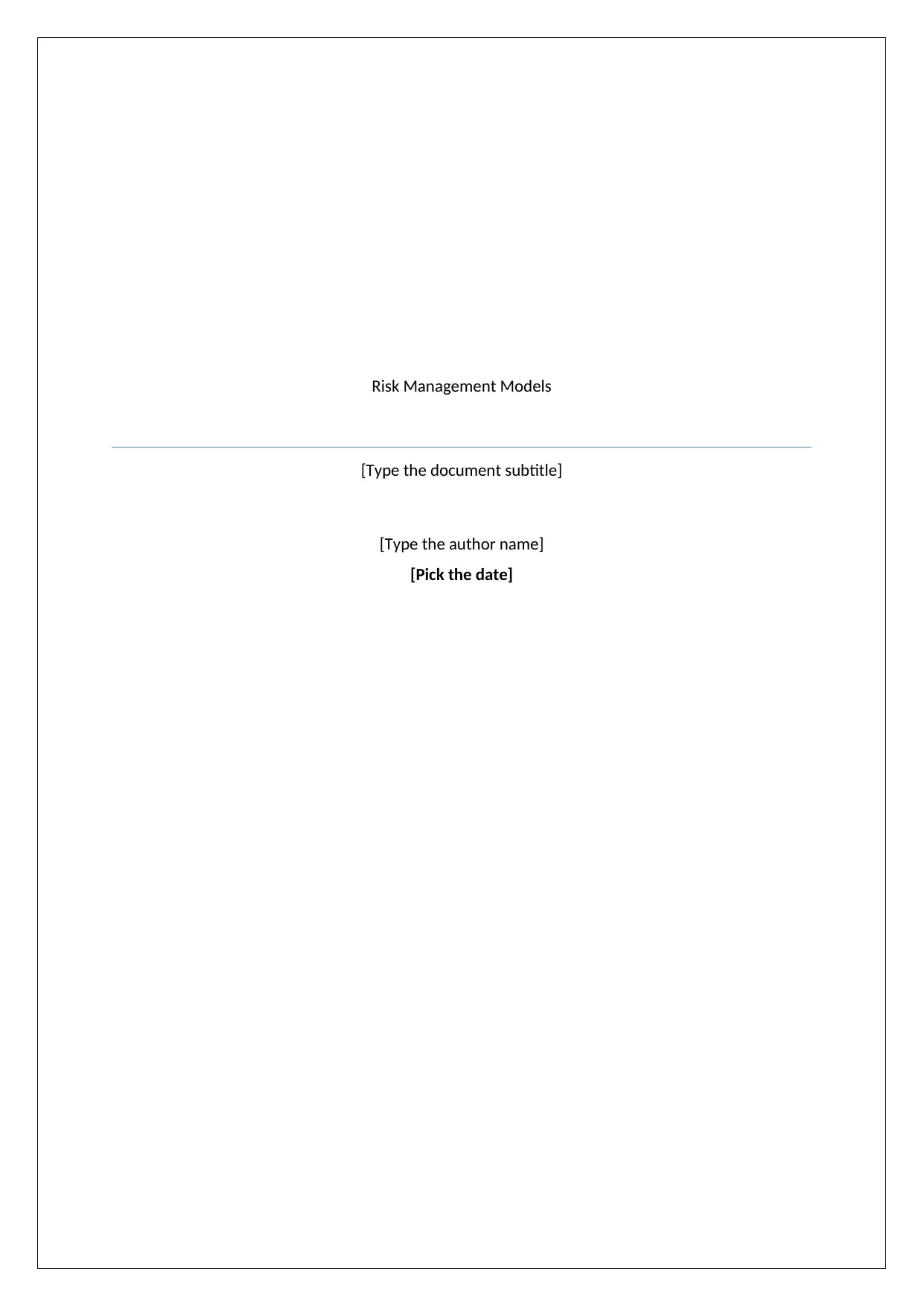
Risk Management Models
[Type the document subtitle]
[Type the author name]
[Pick the date]
[Type the document subtitle]
[Type the author name]
[Pick the date]
Paraphrase This Document
Need a fresh take? Get an instant paraphrase of this document with our AI Paraphraser
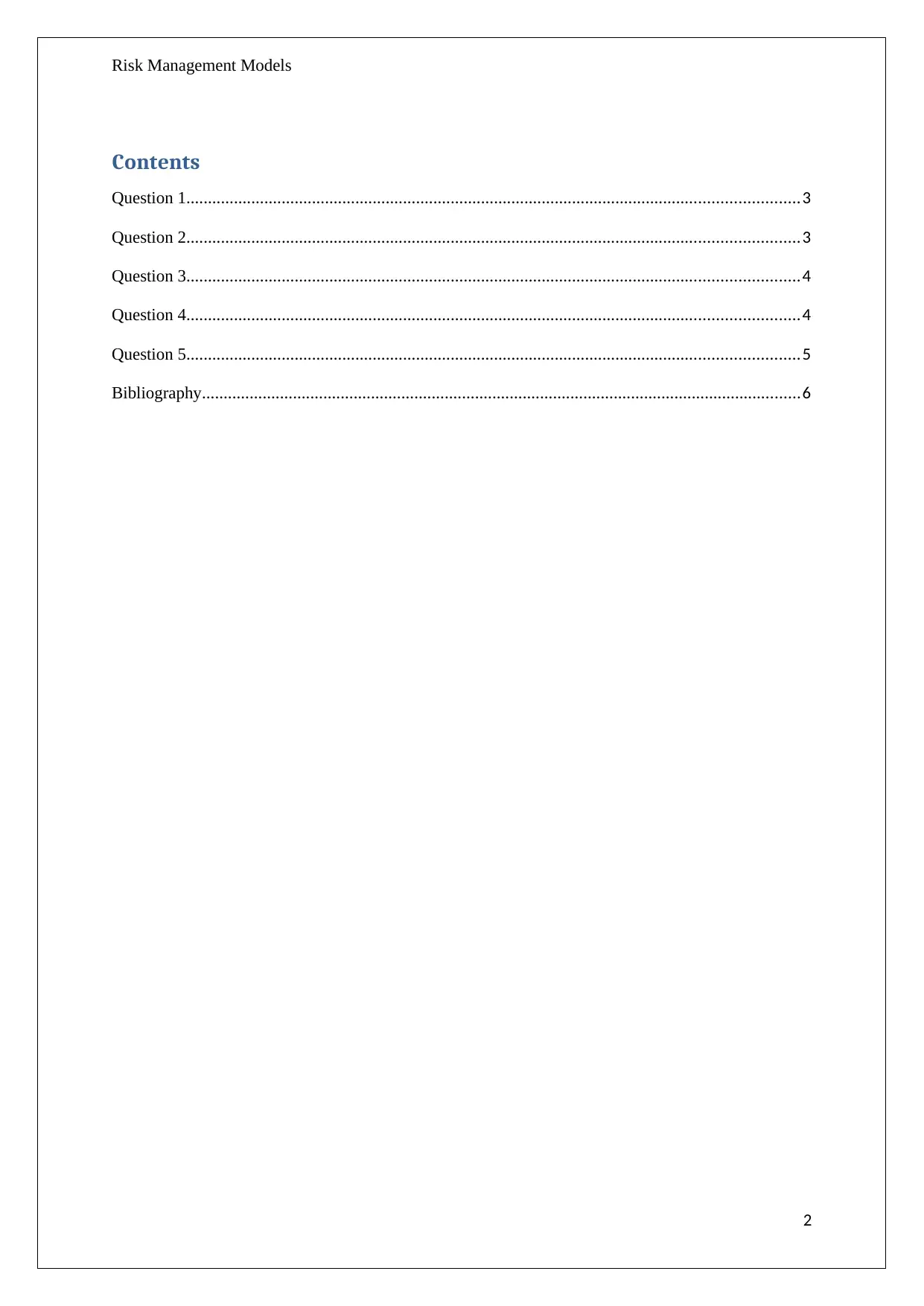
Risk Management Models
Contents
Question 1.............................................................................................................................................3
Question 2.............................................................................................................................................3
Question 3.............................................................................................................................................4
Question 4.............................................................................................................................................4
Question 5.............................................................................................................................................5
Bibliography..........................................................................................................................................6
2
Contents
Question 1.............................................................................................................................................3
Question 2.............................................................................................................................................3
Question 3.............................................................................................................................................4
Question 4.............................................................................................................................................4
Question 5.............................................................................................................................................5
Bibliography..........................................................................................................................................6
2
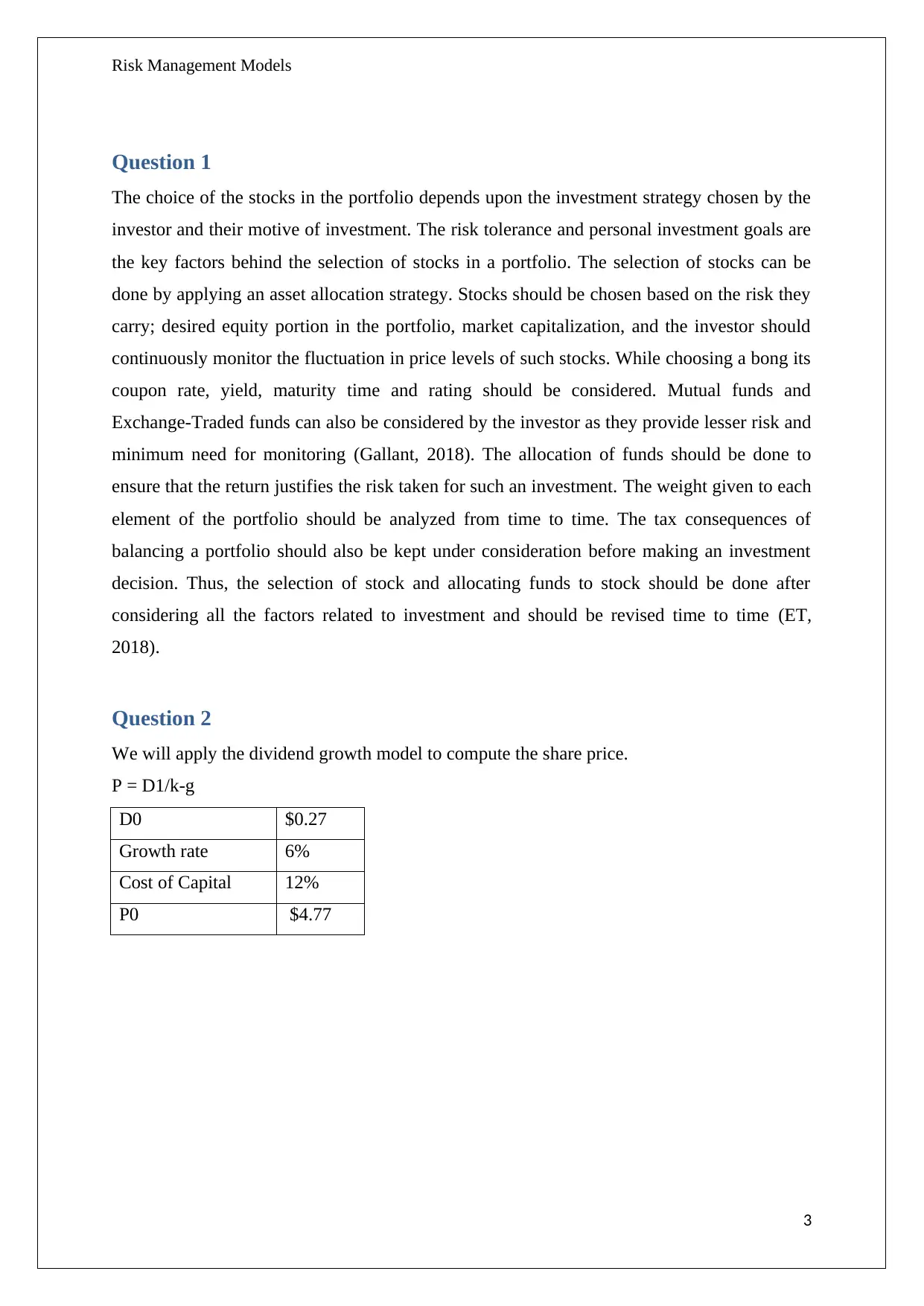
Risk Management Models
Question 1
The choice of the stocks in the portfolio depends upon the investment strategy chosen by the
investor and their motive of investment. The risk tolerance and personal investment goals are
the key factors behind the selection of stocks in a portfolio. The selection of stocks can be
done by applying an asset allocation strategy. Stocks should be chosen based on the risk they
carry; desired equity portion in the portfolio, market capitalization, and the investor should
continuously monitor the fluctuation in price levels of such stocks. While choosing a bong its
coupon rate, yield, maturity time and rating should be considered. Mutual funds and
Exchange-Traded funds can also be considered by the investor as they provide lesser risk and
minimum need for monitoring (Gallant, 2018). The allocation of funds should be done to
ensure that the return justifies the risk taken for such an investment. The weight given to each
element of the portfolio should be analyzed from time to time. The tax consequences of
balancing a portfolio should also be kept under consideration before making an investment
decision. Thus, the selection of stock and allocating funds to stock should be done after
considering all the factors related to investment and should be revised time to time (ET,
2018).
Question 2
We will apply the dividend growth model to compute the share price.
P = D1/k-g
D0 $0.27
Growth rate 6%
Cost of Capital 12%
P0 $4.77
3
Question 1
The choice of the stocks in the portfolio depends upon the investment strategy chosen by the
investor and their motive of investment. The risk tolerance and personal investment goals are
the key factors behind the selection of stocks in a portfolio. The selection of stocks can be
done by applying an asset allocation strategy. Stocks should be chosen based on the risk they
carry; desired equity portion in the portfolio, market capitalization, and the investor should
continuously monitor the fluctuation in price levels of such stocks. While choosing a bong its
coupon rate, yield, maturity time and rating should be considered. Mutual funds and
Exchange-Traded funds can also be considered by the investor as they provide lesser risk and
minimum need for monitoring (Gallant, 2018). The allocation of funds should be done to
ensure that the return justifies the risk taken for such an investment. The weight given to each
element of the portfolio should be analyzed from time to time. The tax consequences of
balancing a portfolio should also be kept under consideration before making an investment
decision. Thus, the selection of stock and allocating funds to stock should be done after
considering all the factors related to investment and should be revised time to time (ET,
2018).
Question 2
We will apply the dividend growth model to compute the share price.
P = D1/k-g
D0 $0.27
Growth rate 6%
Cost of Capital 12%
P0 $4.77
3
⊘ This is a preview!⊘
Do you want full access?
Subscribe today to unlock all pages.

Trusted by 1+ million students worldwide
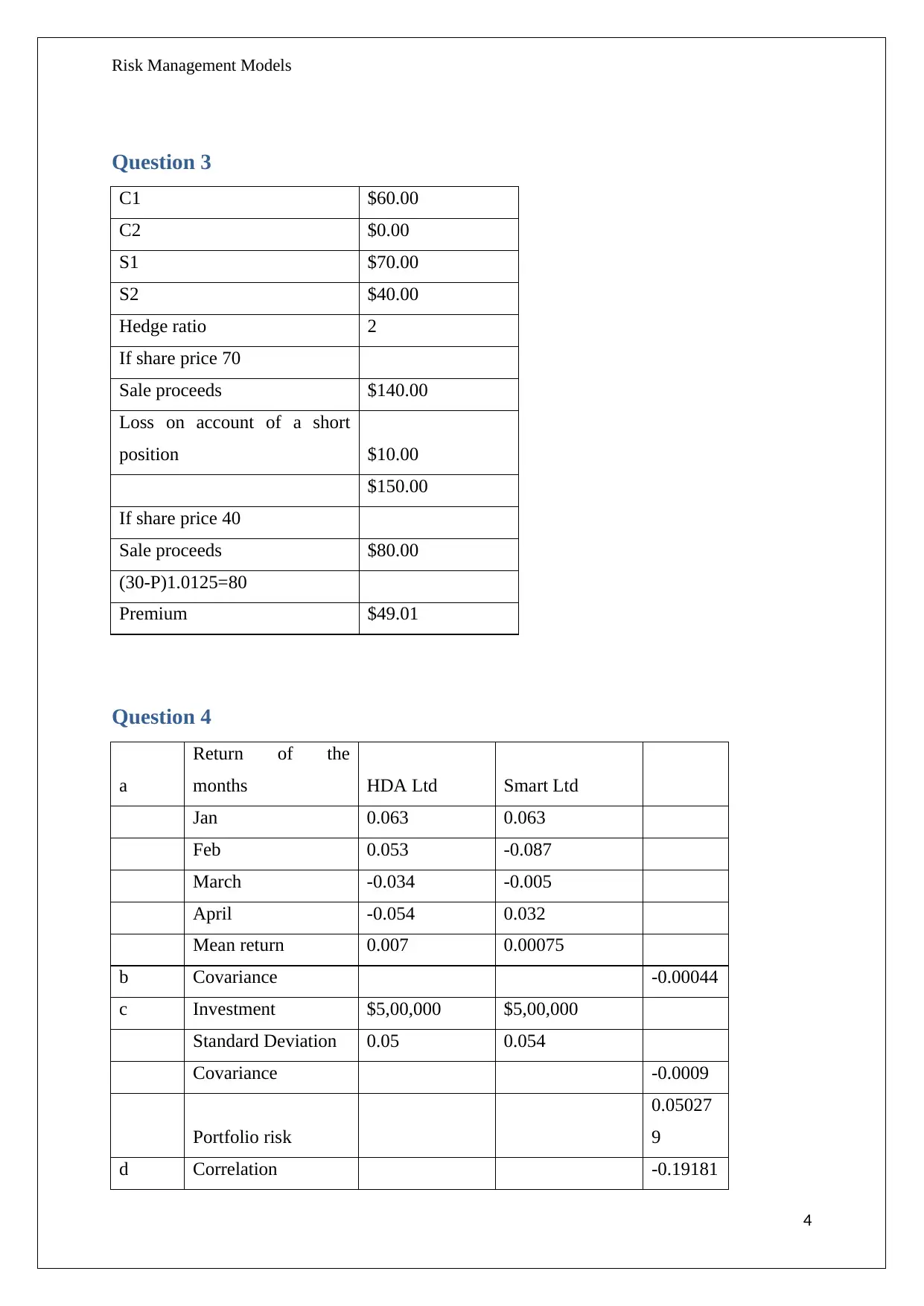
Risk Management Models
Question 3
C1 $60.00
C2 $0.00
S1 $70.00
S2 $40.00
Hedge ratio 2
If share price 70
Sale proceeds $140.00
Loss on account of a short
position $10.00
$150.00
If share price 40
Sale proceeds $80.00
(30-P)1.0125=80
Premium $49.01
Question 4
a
Return of the
months HDA Ltd Smart Ltd
Jan 0.063 0.063
Feb 0.053 -0.087
March -0.034 -0.005
April -0.054 0.032
Mean return 0.007 0.00075
b Covariance -0.00044
c Investment $5,00,000 $5,00,000
Standard Deviation 0.05 0.054
Covariance -0.0009
Portfolio risk
0.05027
9
d Correlation -0.19181
4
Question 3
C1 $60.00
C2 $0.00
S1 $70.00
S2 $40.00
Hedge ratio 2
If share price 70
Sale proceeds $140.00
Loss on account of a short
position $10.00
$150.00
If share price 40
Sale proceeds $80.00
(30-P)1.0125=80
Premium $49.01
Question 4
a
Return of the
months HDA Ltd Smart Ltd
Jan 0.063 0.063
Feb 0.053 -0.087
March -0.034 -0.005
April -0.054 0.032
Mean return 0.007 0.00075
b Covariance -0.00044
c Investment $5,00,000 $5,00,000
Standard Deviation 0.05 0.054
Covariance -0.0009
Portfolio risk
0.05027
9
d Correlation -0.19181
4
Paraphrase This Document
Need a fresh take? Get an instant paraphrase of this document with our AI Paraphraser
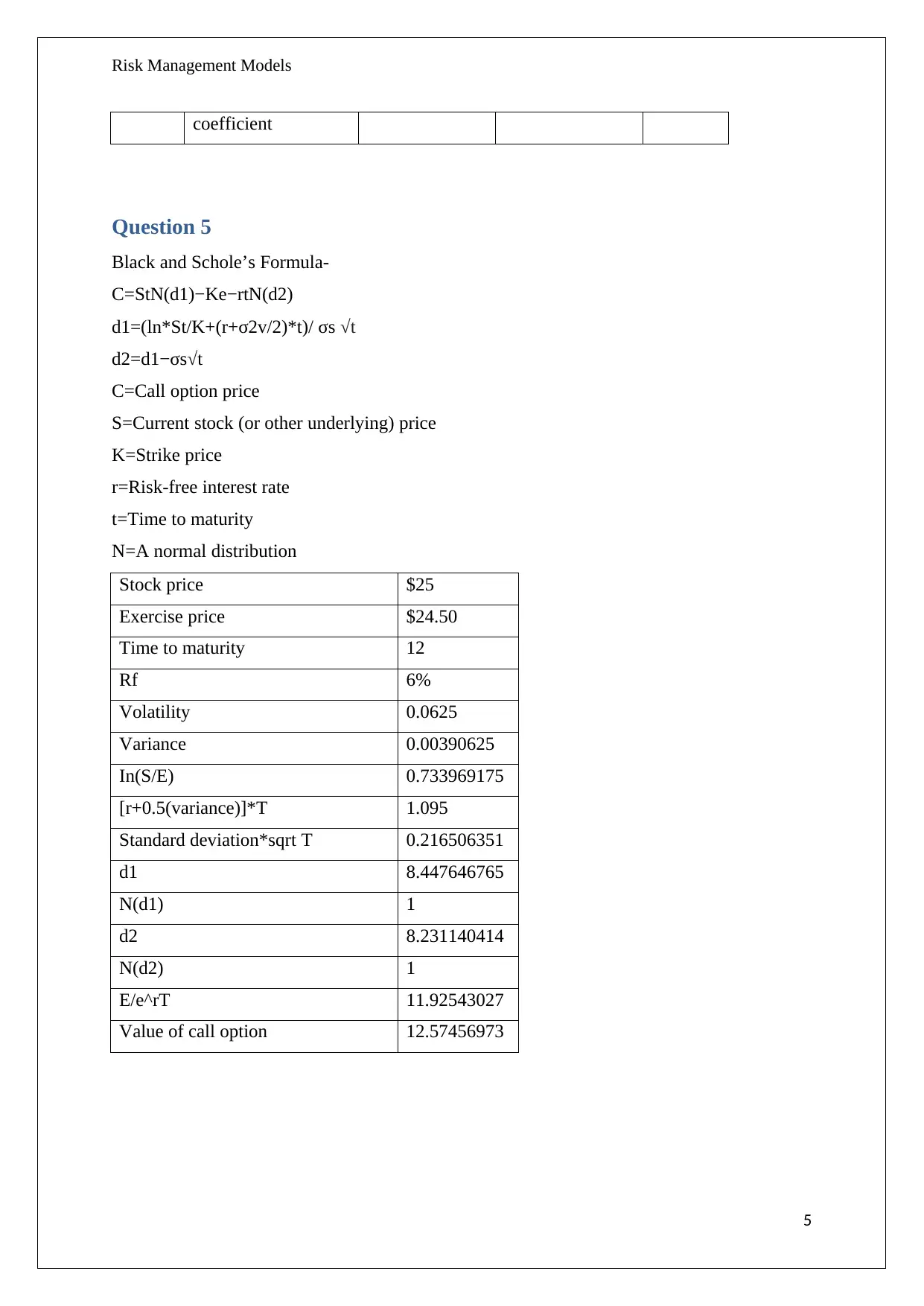
Risk Management Models
coefficient
Question 5
Black and Schole’s Formula-
C=StN(d1)−Ke−rtN(d2)
d1=(ln*St/K+(r+σ2v/2)*t)/ σs √t
d2=d1−σs√t
C=Call option price
S=Current stock (or other underlying) price
K=Strike price
r=Risk-free interest rate
t=Time to maturity
N=A normal distribution
Stock price $25
Exercise price $24.50
Time to maturity 12
Rf 6%
Volatility 0.0625
Variance 0.00390625
In(S/E) 0.733969175
[r+0.5(variance)]*T 1.095
Standard deviation*sqrt T 0.216506351
d1 8.447646765
N(d1) 1
d2 8.231140414
N(d2) 1
E/e^rT 11.92543027
Value of call option 12.57456973
5
coefficient
Question 5
Black and Schole’s Formula-
C=StN(d1)−Ke−rtN(d2)
d1=(ln*St/K+(r+σ2v/2)*t)/ σs √t
d2=d1−σs√t
C=Call option price
S=Current stock (or other underlying) price
K=Strike price
r=Risk-free interest rate
t=Time to maturity
N=A normal distribution
Stock price $25
Exercise price $24.50
Time to maturity 12
Rf 6%
Volatility 0.0625
Variance 0.00390625
In(S/E) 0.733969175
[r+0.5(variance)]*T 1.095
Standard deviation*sqrt T 0.216506351
d1 8.447646765
N(d1) 1
d2 8.231140414
N(d2) 1
E/e^rT 11.92543027
Value of call option 12.57456973
5
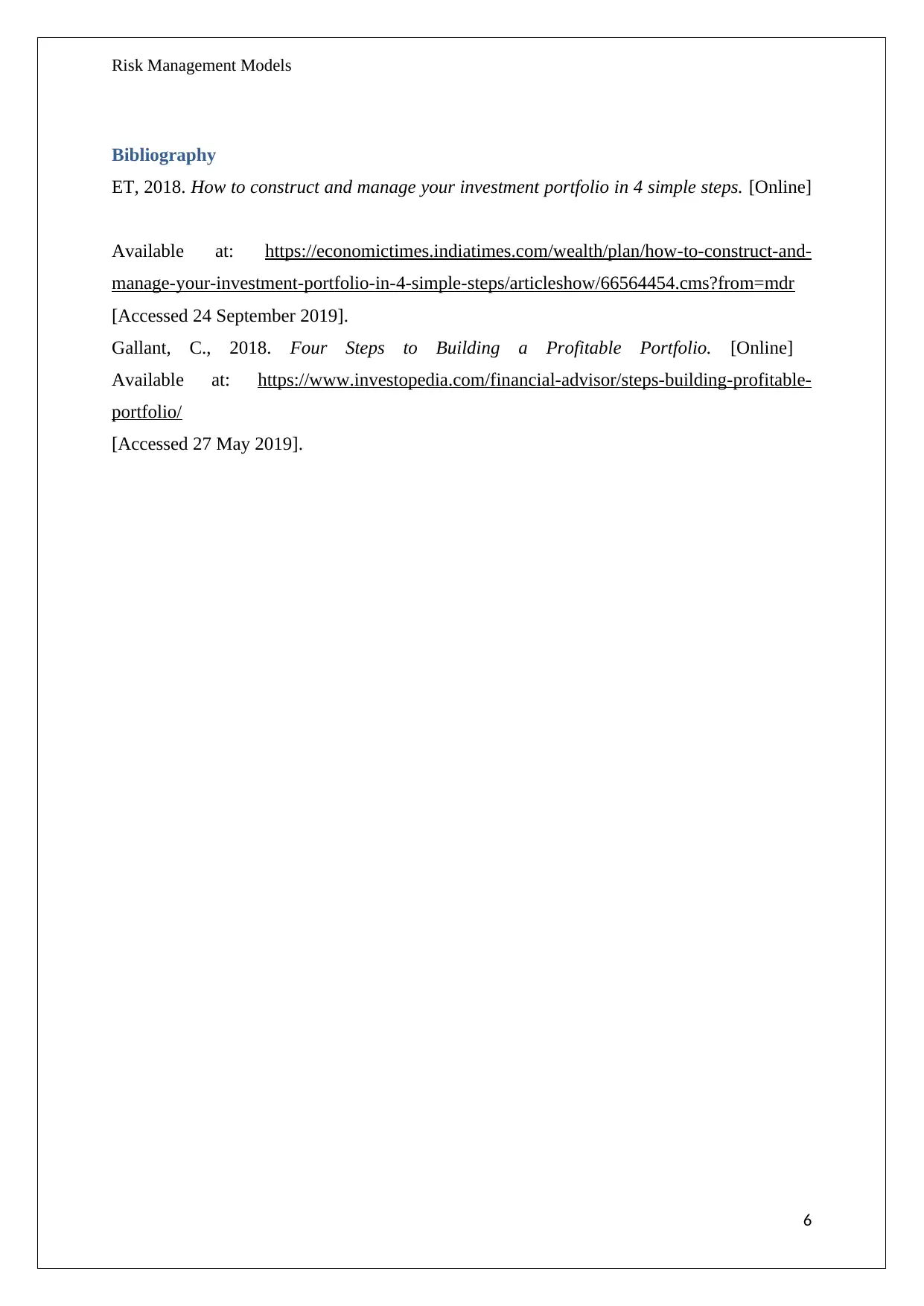
Risk Management Models
Bibliography
ET, 2018. How to construct and manage your investment portfolio in 4 simple steps. [Online]
Available at: https://economictimes.indiatimes.com/wealth/plan/how-to-construct-and-
manage-your-investment-portfolio-in-4-simple-steps/articleshow/66564454.cms?from=mdr
[Accessed 24 September 2019].
Gallant, C., 2018. Four Steps to Building a Profitable Portfolio. [Online]
Available at: https://www.investopedia.com/financial-advisor/steps-building-profitable-
portfolio/
[Accessed 27 May 2019].
6
Bibliography
ET, 2018. How to construct and manage your investment portfolio in 4 simple steps. [Online]
Available at: https://economictimes.indiatimes.com/wealth/plan/how-to-construct-and-
manage-your-investment-portfolio-in-4-simple-steps/articleshow/66564454.cms?from=mdr
[Accessed 24 September 2019].
Gallant, C., 2018. Four Steps to Building a Profitable Portfolio. [Online]
Available at: https://www.investopedia.com/financial-advisor/steps-building-profitable-
portfolio/
[Accessed 27 May 2019].
6
⊘ This is a preview!⊘
Do you want full access?
Subscribe today to unlock all pages.

Trusted by 1+ million students worldwide
1 out of 6
Related Documents
Your All-in-One AI-Powered Toolkit for Academic Success.
+13062052269
info@desklib.com
Available 24*7 on WhatsApp / Email
![[object Object]](/_next/static/media/star-bottom.7253800d.svg)
Unlock your academic potential
Copyright © 2020–2025 A2Z Services. All Rights Reserved. Developed and managed by ZUCOL.





